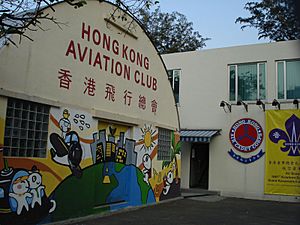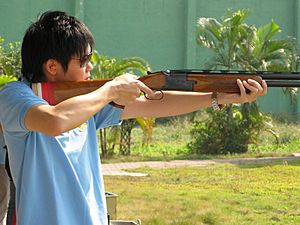Hong Kong Air Cadet Corps facts for kids

Hong Kong Air Cadet Corps Emblem
|
|
| Formation | 7 April 1971 |
|---|---|
| Type | Aviation |
| Purpose | (a) To provide an organization to encourage and aid the people of Hong Kong in their contribution of their efforts, services and resources in the development of civil aviation;
(b) To encourage and develop by example the voluntary contribution of private citizens to the public welfare; (c) To develop within the youth of Hong Kong, by example and inspiration, the qualities of leadership and good moral character; and (d) To promote international goodwill by participating in exchange programmes, rallies, conferences and other activities with overseas youth organisations. |
| Headquarters | Old Hong Kong International (Kai Tak) Airport |
| Location |
|
|
Membership
|
3263 cadets (youth) with 1588 adult members |
|
Official language
|
Cantonese, English |
|
Commanding Officer
|
Group Captain CHAN Man-lang IDSM |
| Website | www.aircadets.org.hk |
| Hong Kong Air Cadet Corps | |||||||||||
|---|---|---|---|---|---|---|---|---|---|---|---|
| Traditional Chinese | 香港航空青年團 | ||||||||||
| Simplified Chinese | 香港航空青年团 | ||||||||||
|
|||||||||||
The Hong Kong Air Cadet Corps (Chinese: 香港航空青年團) is a group where people wear uniforms and volunteer their time. It gets support from the Home Affairs Bureau of the Hong Kong government. It is also a charity that doesn't aim to make money.
This group started in 1971. It used to be connected to the British Armed Forces and the Royal Air Force. The Corps is a disciplined group for young people who are interested in flying and aviation. Its main goals are to help members learn about planes and flying, become good leaders, and help their community. Big airlines like Cathay Pacific Airways and Dragon Air also support the Corps with aviation training.
Besides learning about aviation, members of the Hong Kong Air Cadet Corps (HKACC) take part in many outdoor activities. These include parachuting, rifle practice, visits to interesting places, hiking, and field training camps. They also organize water activities like canoe courses in the summer. A big part of being a member is helping out in the community.
The HKACC is divided into 7 main sections called "wings." These are Hong Kong Island, New Territories East, New Territories West, Kowloon East, Kowloon West, No 6, and Operations Support Wings. Each wing is then split into smaller groups called squadrons. A squadron usually has at least 35 cadets. Many squadrons are based at secondary schools, which helps with recruiting new members and training them.
Contents
History of the Air Cadets
The Hong Kong Air Cadet Corps was officially formed on April 7, 1971. At first, it had strong ties with the British Royal Air Force. However, after Hong Kong was returned to China in 1997, the Corps became a civilian organization. Since 2024, the HKACC has received some funding from the Government Flying Service.
How the Corps is Organized
The top leader of the Hong Kong Air Cadet Corps is the Commanding Officer, Group Captain Chan Man Lang. As the main manager, the Commanding Officer is in charge of the Corps' daily activities. They report to the Executive Board.
The Commanding Officer's Office helps with special tasks at the main headquarters. This includes managing the Honorary Officers Scheme, dealing with legal matters, and connecting with British and Canadian Air Cadet groups.
Groups and Their Missions
The HKACC has several important groups that help it run smoothly:
- The Administration & Support Group handles all the daily tasks. This includes managing money, staff, and buildings. They also organize adventure activities, manage computer systems, and work with government groups. They also handle public relations and medical support.
- The Institutional Advancement Group works on building relationships. They connect with the government, other groups in mainland China, parents, and other youth organizations. They also arrange international and mainland exchange programs and special projects.
- The Operations Group directly leads the five main operational wings. This group is responsible for organizing and managing the activities of cadet and university squadrons. They make sure that all units follow the training goals set by the Headquarters. They also ensure the Corps completes its community service duties.
- The Training Group sets the standards and plans for all training within the Corps. They regularly update these standards based on what the community needs and new technologies. This group also runs advanced courses. These include aviation education, training for adult members, and special skills training.
- The Flying Squadron organizes activities where cadets can experience flying. They also make sure that all flight operations are safe and follow aviation rules.
Structure of Squadrons
Most cadet squadrons are part of the Operations Group. This group is divided into four wings. There is also the Ceremonial Squadron which is part of the Ceremonial Wing under the Training Group.
| Group | Administration Group (Admin Gp) | Training Group (Trg Gp) | Development and Support Group (SD&S Gp) | Operations Group (Ops Gp) | Aviation
Education and Development Group (AE&D Gp) |
|---|---|---|---|---|---|
| DCO | DCO Admin
Wg Cdr W W S CHAN |
DCO Trg
Wg Cdr R K P KWONG |
DCO SD&S
Ag Wg Cdr F C CHAN |
DCO Ops
Wg Cdr A Y W LAW |
DCO AE&D
Wg Cdr I P K CHAN |
| OC Group | OC Admin Gp
Vacant |
OC Trg Gp
Sqn Ldr J C Y CHAN |
OC SD&S Gp
Sqn Ldr V Y K AU |
OC Ops Gp
Sqn Ldr B K P YUEN |
OC AE&D Gp
Sqn Ldr F W C TSE |
Administration Group Units
- Medical Squadron
- Adventure Activities Squadron
- Supply Flight
- Public Affairs Flight
Training Group Units
- Adult Training Wing
- Ceremonial Wing
- Vocational Qualifications Unit
Skills Development and Support Group Units
- Support Services Wing
- General Service Training Wing
- Skills Development Wing
- Community and Mainland Activities Wing
Operations Group Wings and Squadrons
| Wing | Hong Kong Island Wing | |||||||
|---|---|---|---|---|---|---|---|---|
| OC Wing | OC HKI Wg
Sqn Ldr M K B CHOI |
|||||||
| Squadron | 101 Squadron | 102 Squadron | 103 Squadron | 104 Squadron | 105 Squadron | 106 Squadron | 107 Squadron | 108 Squadron |
| Location | Hong Kong University Graduate Association College | Causeway Bay Community Centre | Tang Shiu Kin Victoria Government Secondary School | Buddhist Federation Youth Center | Unknown | Unknown | St. Peter's Secondary School | The Church of Christ in China Kwei Wah Shan College |
| Wing | Kowloon Wing | ||||||||||
|---|---|---|---|---|---|---|---|---|---|---|---|
| OC Wing | OC Kln Wg
Ag Sqn Ldr E S C CHIU |
||||||||||
| Squadron | 201 Squadron | 202 Squadron | 203 Squadron | 213 Squadron | 401 Squadron | 403 Squadron | 404 Squadron | 405 Squadron | 406 Squadron | 407 Squadron | 408 Squadron |
| Location | Hong Kong Taoist Federation Yunquan School | HKTA The Yuen Yuen Institute No.3 Secondary School | Unknown | QualiEd College | Buddhist Tai Hung College | Wah Yan College, Kowloon | HKMA David Li Kwok Po College | Jockey Club Government Secondary School | Unknown | Unknown | Yu Chun Keung Memorial College |
| Wing | New Territories Wing | ||||||||||||
|---|---|---|---|---|---|---|---|---|---|---|---|---|---|
| OC Wing | OC NT Wg
Sqn Ldr W C F CHAN |
||||||||||||
| Squadron | 301 Squadron | 302 Squadron | 303 Squadron | 304 Squadron | 308 Squadron | 313 Squadron | 3002 Flight | 501 Squadron | 502 Squadron | 504 Squadron | 505 Squadron | 506 Squadron | 507 Squadron |
| Location | CUHKFAA Chan Chun Ha Secondary School | Kwok Tak Seng Catholic Secondary School | Hong Kong Taoist Association The Yuen Yuen Institute No.2 Secondary School | Unknown | Shatin Government Secondary School & Lam Tai Fai College |
Sheng Kung Hui Tsang Shiu Tim Secondary School | Law Ting Pong Secondary School | Queen Elizabeth School Old Students' Association Secondary School & YLPMSAA Tang Siu Tong Secondary School | Unknown | San Wui Commercial Society Secondary School | Stewards Ma Kam Ming Charitable Foundation Ma Ko Pan Memorial College | Queen's College Old Boys' Association Secondary School | Lai King Catholic Secondary School |
| Wing | No 6 Wing | |||||||||||
|---|---|---|---|---|---|---|---|---|---|---|---|---|
| OC Wing | OC No 6 Wg
Ag Sqn Ldr C T C O R |
|||||||||||
| Squadron | 601 Squadron | 602 Squadron | 603 Squadron | 604 Squadron | 605 Squadron | 606 Squadron | 607 Squadron | 608 Squadron | 609 Squadron | Central Training Squadron | 6010 Flight | 6011 Flight |
| Location | Sir Ellis Kadoorie Secondary School (West Kowloon) | HKU SPACE | Education University of Hong Kong | Chinese University of Hong Kong | Hong Kong University of Science and Technology | Police Sports Recreation Club | Lingnan University | Open University of Hong Kong | Hong Kong Polytechnic University | Lehua Catholic Primary School | UOW College Hong Kong | IVE (Tsing Yi) |
Aviation Education and Development Group Units
- Aviation Education Wing
- Flying Squadron
- Technical Operations & Support Wing
- Development Unit
Ranks in the HKACC
The Hong Kong Air Cadet Corps has different ranks for its members, just like in other uniformed groups. These ranks show a member's experience and responsibilities.
| Warrant Officer | Instructors | ||
|---|---|---|---|
| Rank | Warrant Officer (WO) | Sergeant Instructor (Sgt Instr) | Instructor (Instr) |
| Insignia |  |
 |
|
| Ranks | Officer Cadets (Off Cdt) | Officer Trainee (OT) | Recruit Instructor (RI) |
|---|---|---|---|
| Insignia |
| Senior Non-commissioned Officer (SNCO) | Junior Non-commissioned Officer (JNCO) | Cadets | |||||
|---|---|---|---|---|---|---|---|
| Rank | Cadet Warrant Officer (CWO) | Cadet Flight Sergeant (FS) | Cadet Sergeant (Sgt) | Cadet Corporal (Cpl) | Cadet Lance Corporal (LCpl) | Basic Cadet (BC) | Recruit Cadet (RC) |
| Insignia |  |
 |
 |
 |
 |
||
Advanced Aviation Education Programme (AAEP)
The Advanced Aviation Education Programme (AAEP) started in 1997. At first, only members of the HKACC and other uniformed youth groups could join. In 2000, the program became open to everyone. That same year, Cathay Pacific Airways became a partner, and later, the UOW College Hong Kong also joined.
The AAEP helps participants get the basic training needed to take the Australian Civil Aviation Safety Authority General Flying Practical Test (GFPT). If you pass all the tests, you get a Certificate of Achievement from the HKACC. Graduates can also get credit if they apply for the Associate Degree of Science in Airport Operations and Aviation Logistics (AScAOAL) at UOW College Hong Kong. HKACC cadets who complete the program are considered to have passed all Aviation Education subjects needed for higher cadet ranks.
To complete the program, participants must finish 8 required subjects. These are split into two main parts, with a total of 20 sessions:
Technical Modules
- Aerodynamics (ADY): This is about how air moves around planes.
- Aircraft General Knowledge (AGK): Learning about how planes are built and how they work.
- Operation, Performance, and Planning (PERF): How to plan flights and understand a plane's abilities.
- Flight Rules & Air Laws in Australia (LAW): The rules and laws for flying in Australia.
- Navigation (NAV): How to find your way when flying.
- Meteorology (MET): Learning about weather and how it affects flying.
- Radio Communication (RT): How to talk on the radio while flying.
- Human Performance and Limitation (HPL): Understanding how human bodies and minds work in flying.
Practical Module
- Flight Simulation Training (FST): This is done using flight simulators, taught by instructors from the New Zealand (HK) Flight Training Academy.
Activities and Exchanges
Cadets in the HKACC get to take part in exciting activities. These include the International Air Cadet Exchange, where they can meet cadets from other countries. They also participate in international shooting contests.
Aircraft Used
For flight experience in Hong Kong, the Corps uses helicopters like:
- Robinson R44
- Eurocopter EC120
Glider training, which involves flying planes without engines, is provided through programs in Canada and Australia. It is also offered by private flying clubs in Canada and New Zealand.
See also
- Cadets (youth program)












